~~ Book Published by The Kobunsha / T. Hasegawa ~~
Aino Fairy Tales No. 3
The Man Who Lost His Wife
By B.H. Chamberlain
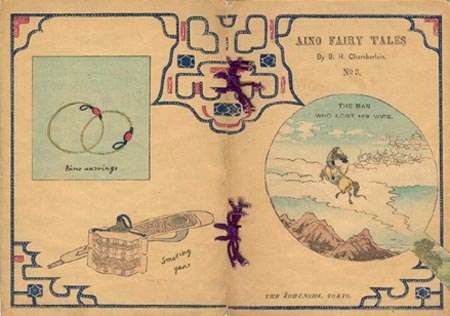
|
Go To: Aino Fairy Tales No. 1
The Hunter in Fairy-Land |
Go To: Aino Fairy Tales No. 2
The Birds' Party |
This is: Aino Fairy Tales No. 3
The Man Who Lost His Wife |
|
Chamberlain, Basil Hall
Hasegawa, T. (Publisher):
Aino Fairy Tales No. 3, The Man Who Lost His Wife, Tokyo (3 Maruya-cho, Kyobashi-ku), The Kobunsha, 1889 (Meiji 22), 12mo (5 1/4 x 7 1/4 in - 13.4 x 18.8 cm), medium size for a Hasegawa publication, tan mulberry paper (not folded except for the covers), cord tied with the cord extending around the spine, spine not covered, 14 pages total including the covers. Four of the adjoining woodblock illustrations form a continuous image (diptych) across the two pages. The front and back covers also complete a continuous image. This was the last book in the Anio Tales series.
The first two books in this series carried the imprint of Ticknor & Co., Boston. This book does not contain that imprint.
A copy of this book has been recorded with the "T. Hasegawa, Tokyo, Publisher" imprint on the front cover rather than "The Kobunsha, Tokyo" imprint. Both books have the same colophon and are identical.
The 3 Maruya-cho address is a very rare address for Hasegawa publications as it was only occupied by Hasegawa for approximately one year. This book and The Ogre's Arm (Fairy Tale No. 18, August, 1889) are the only two books I have seen with this address. This was the last address associated with The Kobunsha. The next address (10 Hiyoshi-cho) marked the assumption of the T. Hasegawa imprint.
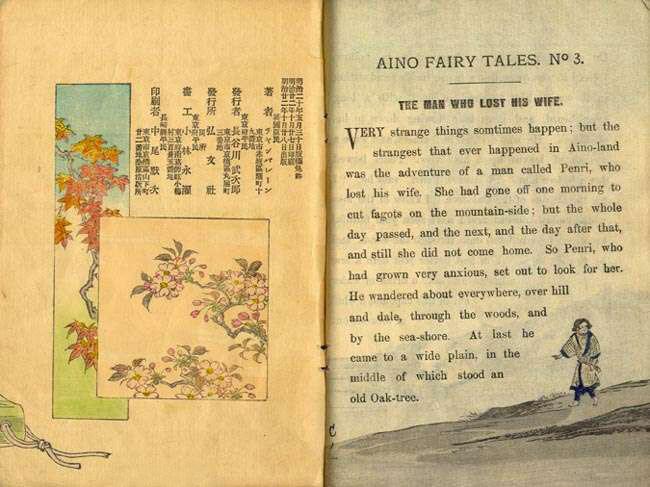

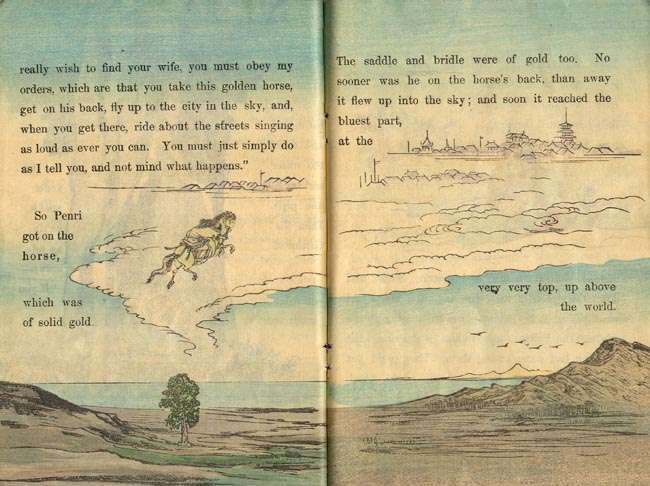
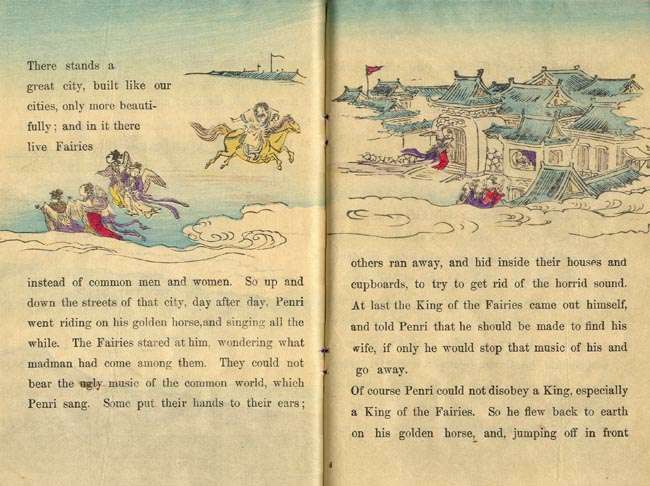

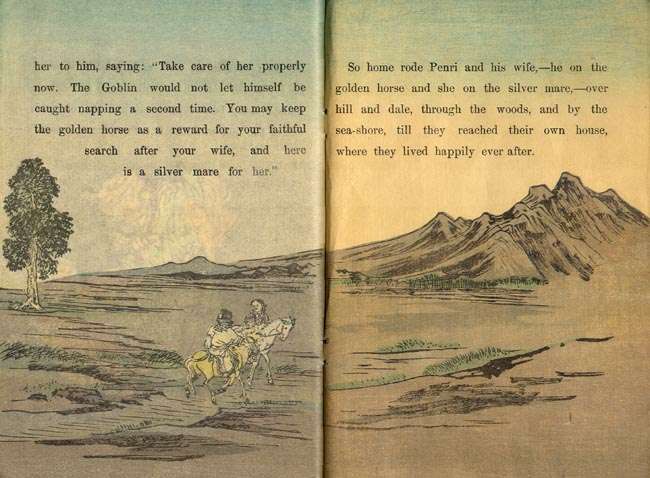
Colophon

Copyrighted: Meiji 20 (1887).5.30
Printed: Meiji 22 (1889).10.27
Published: Meiji 22 (1889).10.28
Author: Chamberlain
Publisher: Hasegawa Takajiro, 3 Maruya-cho, Kyobashi-ku, Tokyo
Woodblock Printer: Komiyo Sojiro
Text Printer: Nakao Mokuji
Text of This Aino Fairy Tale:
Aino Fairy Tales. No 3.
The Man Who Lost His Wife.
Very strange things sometimes happen: but the strangest that ever happened in Aino-land was the adventure of a man called Penri, who lost his wife. She had gone off one morning to cut fagots on the mountain-side; but the whole day passed and the next, and the day after that, and still she did not come home. So Penri, who had grown very anxious, set out to look for here. He wandered about everywhere, over hill and dale, through woods, and by the sea-shore. At last he came to a wide plain, in the middle of which stood an old Oak-tree.
On going up to it, he found it to be hollow. Indeed it was quite like a house inside; and sitting in it was a kind-looking old man, with a long gray beard, and gray hair flowing down to his shoulders. He was dressed in feathers, and wore a wreath of leaves upon his brow. Penri bowed down before him. "Welcome Penri," said he: "I am the Genius of the Oak-tree. I know of the loss which makes you sad, and I have seen your faithful search all over hill and dale, through the woods and by the sea-shore. You had better rest here a few minutes, and take a drink of water out of this cup, and a whiff of tobacco out of this pipe of mine." So Penri sat down and drank the water and smoked the pipe. Then the Genius of the Oak-tree spoke again as follows:"If you really wish to find your wife, you must obey my orders which are that you take this golden horse, get on his back, fly up to the city in the sky, and when you get there, rid about the streets singing as loud as ever you can. You must just simply do as I tell you and not mind what happens." So Penri got on the horse, which was of solid gold. The saddle and bridle were of gold too. No sooner was he on the horse's back, than away it flew up into the sky; and soon it reached the bluest part, at the very top, up above the world.
There stands a great city, built like our cities, only more beautifully; and in it there lives Fairies instead of common men and women. So up and down the streets of that city, day after day, Penri went riding on his golden horse, and singing all the while. The Fairies stared at him wondering what madman had come among them. They could not bear the ugly music of the common world, which Penri sang. So put there hands to their ears; others ran away, and hid inside their houses and cupboards, to try to get rid of the horrid sound. At last the King of the Fairies came out himself, and told Penri that he should be made to find his wife, if only he would stop that music of his and go away.
Of course Penri could not disobey a King, especially a King of the Fairies. So he flew back to earth on his golden horse, and, jumping off in front of the Oak-tree, said to the old man with the gray beard and the wreath on his head; "Here I am. I did as you bade me; but I have not found my dear wife."
"Perhaps not: but you shall now," replied the old man. "You don't know all the trouble which you have caused in the sky; neither have I yet told you how it was that your wife disappeared. I will tell you. It was a wicked Goblin who stole her, and carried her off to the cave below the earth, where his home is. There he popped her into his strong-box, meaning to eat here as soon as he should feel hungry. This Goblin, hearing a great noise going on in the sky, looked up, and was so much surprised at the strange sight of a man on a golden horse riding up and down the street singing and making all the Fairies run away, that he cannot take his eyes off it even now. He has
forgotten everything else, and is still looking. So I will tell you what I will do. I will hobble round quietly behind his back, and let your wife out of the box while he is not paying attention." "Oh, thank you!" said Penri. So the old man did as he had promised, and soon came back with Penri's lost wife, and gave her to him, saying: "Take care of her properly now. The Goblin would not let himself be caught napping a second time. You may keep the golden horse as a reward for your faithful search after your wife, and here is a silver mare for her."
So home rode Penri and his wife, -- he on the golden horse an she on the silver mare, -- over hill and dale, through the woods, and by the sea-shore, till they reached their own house, where they lived happily ever after.
General Information Regarding The Aino Fairy Tale Series

Aino Fairy Tale No. 1
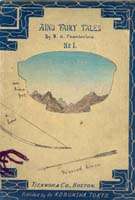
The Hunter in Fairy-Land |
Aino Fairy Tale No. 2
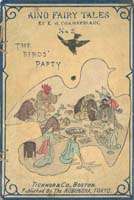
The Birds' Party |
Aino Fairy Tale No. 3

The Man Who Lost His Wife |
Basil Hall Chamberlain (1850-1835) studied and lived with the Aino (Ainu) of Northern Hokkaido in the mid-1880s. He paid particular attention to their folk-tales. In 1888 he published a book titled Aino Folk-Tales. The book can be found on-line here. In this book Chamberlain noted the Hasegawa Aino Fairy tales in this manner:
Of course Aino tales, like other tales, may also be treated from a literary point of view. Some of the tales of the present collection, prettily illustrated with pictures by Japanese artists, and altered, expurgated, and arranged virginibus puerisque, are at the present moment being prepared by Messrs. Ticknor & Co., of Boston, who thought with me that such a venture might please our little ones both in England and in the United States. But such things have no scientific value. They are not meant to have any. They are mere juvenile literature, whose English dressing-up has as little relation to the barbarous original as the Paris fashions have to the anatomy of the human frame. (Chamberlain, 1888, Aino Folk-Tales, Prefatory Remarks at page 5)
In Chamberlain's view, the Aino fairy tale is much different from those found in Japanese and Western folk-lore. He described this in these terms:
At the same time, the general tenour and tendency of the tales and traditions of the Ainos wear a widely different aspect from that which characterises the folk-lore of Japan. The Ainos, in their humble way, are addicted to moralising and to speculating on the origin of things. A perusal of the following tales will show that a surprisingly large number of them are attempts to explain some natural phenomenon, or to exemplify some simple precept. In fact they are science, physical science and moral science, at a very early stage. The explanations given in these tales completely satisfy the adult Aino mind of the present day. The Aino fairy-tales are not, as ours are, survivals from an earlier stage of thought. Even if not invented of recent years they fit in with the present Aino view of things, so much so, that an Aino who recounts one of his stories does so under the impression that he is narrating an actual event. He does not 'make believe' like the European nurse, even like the European child, who has always, in some nook or corner of his mind, a presentiment of the scepticism of his later years. (Chamberlain, 1888, Aino Folk-Tales, Prefatory Remarks at page 3-4)
It is interesting to compare these Hasegawa/Kobunsha published version of the Anio Fairy Tales with Chamberlain's versions published in 1888. The Hasegawa Aino Fairy Tale No. 1 (The Fairy-Tale Hunter) is titled "The Hunter in Hades" in Hearn's 1888 book. The Hasegawa published version of the tale omits any reference to hades, instead calling it "Fairy-Land." Faiy Tale No. 2 (The Bird's Party) is titled is titled "The "Angry Crow" in Hearn's 1888 book. Regarding this tale, Chamberlain presents two versions, one being provided to him by John Bachelor. The Bachelor version is the one used in the book but instead of dropping a rock, as in the Hasegawa published version, the crow drops a piece of hard dung. In the Hasegawa/Kobunsha Aino Fairy Tale No. 3 (The Man Who Lost His Wife) there is a reference to the irritating singing of the of the Aino man looking for his lost wife. In the Chamberlain's 1888 rendition (same title), there is no reference to singing. The reference is to the man's bad smell.
The colophons in Anio Fairy Tales No. 1 and No. 2 are abbreviated. They merely give the date of Meiji 20 (1887).4.13 as the copyright date. They also list Takejiro Hasegawa, 2 Minami Saegi-cho, Kyobashi-ku, Tokyo as the publisher. No text or woodblock printers are listed. The colophon in the third book (here) is very complete. It provides comprehensive information on copyright (Meji 20 (1887).5.30), printing (Meiji 22 (1889).10.27), publication (Meiji 22 (1889).10.28), author (Chamberlain), publisher (Takejiro Hasegawa, 3 Maruya-cho, Kyobashi-ku, Tokyo), woodblock printer (Komiyo Sojiro) and the text printer (Nakao Mokuji). A composite view of all three colophons is here.
I have examined the first two numbers of this series with the Ticknor & Co., Boston, imprint. I have examined the third number without the Ticknor imprint. I do not know if the first two numbers were published without that imprint or whether the third was published with it. These books have been associated with Trubner & Co., London. However, I have not confirmed a book with that imprint.
In 1887 Ticknor & Co. advertised the first two books in these terms:
The Hunter in Fairy Land.
Aino Fairy Tales, No. 1. 40 cents
The Bird's Party.
Aino Fairy Tales, No. 2. 30 cents
By Basil H. Chamberlain. Published by the Kobunsha, Tokyo, Japan; and by Ticknor & Co. Boston. Each in one booklet. 12mo, illuminated paper covers.
These dainty and beautiful little works are printed on the most delicate and silky Japanese paper, with quaint colored illustrations in the text and on the covers; and are bound with knotted silken cords. Ticknor & Co., Boston.
(Advertisement published in The Literary World, Volume XVIII, December 10, 1887, at page 465).
I have not seen a report of these books in crepe paper format and doubt if they were ever produced in that format. It appears these are the only books of this type which were marketed by Hasegawa only in the plain paper versions.
According to Sharf, Hasegawa recognized a great interest by Westerners in the Aino but, in reference to the Aino Fairy Tale Series, "...this did not result in large sales." (Sharf at page 15)
These do appear to be some of rarest books in the Fairy Tale series published by Takejiro Hasegawa. They rarely appear on the market individually and even less often as a complete set. In his discussion of Hasegawa books, Michael Hollander characterized these as "Very rare and desirable." (Hollander at page 341)
I find the cord ties used on these books unique for a Kobunsha/Hasegawa publication. Normally the Kobunsha/Hasegawa books employed stab ties that were secured by a knot snugged against the top of front cover. On these books the cord ties are knotted at the side and snugged up against the spine.
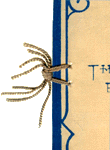
Main Hasegawa Page
General Information Regarding T. Hasegawa Publications
Fukuro-Toji Bound Picture Books. The books published by Takejiro Hasegawa are in the nature of books falling under the Japanese generic descriptive title of Ehon ("e" - picture "hon" - book). They are generally bound in the traditional Japanese book binding style know as "fukuro-toji" which means "pouch binding." In this binding process sheets of paper are printed (woodblock and/or text) on only one side. They are then folded in half with the printed side out. The folded printed sheets are then stacked together along with similarly printed and folded covers and the unit secured along the spine, which is the side opposite the folds, to form the book. This technique gives you the folded pages (double leaves) which are open at the top and bottom forming the pouch ("fukuro") which the binding technique is named after. As a general rule the "fukuro-toji" books are secured/tied with (Yotsume toji bindings) in where four small holes are made along the spine edge and the sheets and covers are then bound together tightly with string or thread ties that wrap around the spine. Generally the spine is not covered except for small portions at the top and bottom. Hasegawa seldom used this form of binding. However, some of the early first editions are found secured in the traditional four hole string tie fashion. I have only seen this with the plain paper books. Most Hasegawa books were secured at the spine using two stab type holes (one at the top and one at the bottom) and secured by silk string or silk ribbon ties (Yamato toji binding). Large books consolidating several individual books are found bound with Kangxi bindings. A very few were tied in a Western style with the string binding concealed under the outside portion of the front and back covers. The paper used was a high quality wood (no rag content) based "washi," generally manufactured from mulberry. The majority of the books were crepe ("chirimen") paper. These are referred to as "chirimen-bon" (crepe paper book) in Japanese. The crepe paper process occurred between the printing process and binding processes. Hasegawa's books were uniformly of high quality in all aspects; paper, ink, execution of the art and text, printing (woodblock printing and Western type face text printing), assembly and binding.
Key Actors in the Production Process. These books involved several key actors in the production process.
- Publisher/Editor. Kobunsha/Takejiro Hasegawa or his successor.
- Author/Translator. Since these books were intended for markets outside of Japan, Hasegawa employed numerous prominent foreigners for this task. Many famous Westerners living in Meiji Japan were associated with Hasegawa's work. Occasionally, Hasegawa would be commissioned by others to produce their work. However, the overwhelming majority of the books were published at his initiative and under his control.
- Artist. Hasegawa retained a group of artists to execute the illustrations for his work.
- Text Printer. The text printing in the books was executed by a different printer from the woodblock printer.
- Woodblock Printer. The woodblocks would be produced from the artist's work and then printed by the woodblock printer. It appears that most of the woodblock printing was done by the Komiya family.
Frederic Sharf, in his work Takejiro Hasegawa, Meiji Japan's Preeminent Publisher of Wood-Block-Illustrated Crepe-Paper Books (see here) records a remarkable amount of information on all these key individuals. In his bibliography of these books, he documents the books and, as far as the information was available, gives the names of these key people. His book also provides an in depth discussion of Hasegawa's life and business and the key authors and translators he employed. Sharf's work is an essential resource for the collector and student of these books.
Size. There are four basic sizes of the crepe paper books.
- Very Small Size -- large 32mo (3 1/2 x 6 in - 10 x 15.2 cm). The smallest size I have seen in the Japanese Fairy Tale books (not calendars, however).
- Small Size -- small 18mo (4 x 6 in - 10.3 x 15.2 cm). This is the standard size for the Fairy Tale Series books.
- Medium Size -- large 18mo (4 3/4 x 6 1/2 in - 12 x 16.5 cm).
- Medium Size -- 12mo (5+ x 7+ in - 13.4 x 18.8 cm) typical plain paper size.
- Large Size -- large 12mo (6 x 7 1/2 in - 14.8 x 19 cm).
- Very Large Size -- 8vo (7+ x 9+ in) primarily the plain paper books.
It is possible to generalize on size of crepe books versus plain paper books. The plain paper books are approximately 50% larger than the counterpart version on crepe paper. As a general rule the plain paper books measure 12.3+ x 18+ cm while the same book in crepe paper measures 9.8+ x 15+ cm. Since the crepe books were first completed in a plain paper format and the paper then creped, perhaps the difference is shrinkage during that process.
Crepe/Plain Paper. In the second edition of Oyuchasan, published in 1893, Hasegawa advertised The Japanese Fairy Tale Series, Nos. 1-20 in "Ordinary Paper & Crepe Paper." On this matter, Sharf notes that the Maruzen company in Tokyo sold Hasegawa/Kobunsha books and until 1893 all listed in company catalogues were on plain paper. The 25 numbers of the First Japanese Fairy Tale Series, as well as No 1 & 2 of the Second Series, were apparently all sold in plain paper versions. They were also sold in crepe paper versions.
Bindings. Discussed and illustrated below.
Wraparound Cases (Chitsu). A very few of the Hasegawa books were sold with tradational Japanese wraparound cases (bone/ivory clasps) although they are seldom seen with material currently being offered commercially. When the books are enclosed in these hinged cases, the top and bottom of the case are open. The following have been confirmed with folding cases:
- Dichtergusse Aus Dem Osten, Japanishce Dichtungen
- Poetical Greetings from the Far East
- White Aster
- Japanische Dichtungen, Weissaster
- Sword and Blossom Poems, 3 volumes (padded folding cover with title and plain with no lettering).
- Japanische Dramen: Terakoya u. Asagao
- Lafcadio Hearn's five book Japanese Fairy Tale sets.
Colophons (Japanese Language). The books contain Japanese language colophons, generally at the rear. These colophons usually state:
- Date Printed
- Date Published
- Author/translator
- Editor and Publisher - Takejiro Hasegawa with the Tokyo Address
- Woodblock Printer and Address
- Text Printer and Address.
They also generally state in English and/or Japanese - "Copyright Reserved" / "All Rights Registered and Reserved." An example of a colophon with English translations annotated is here. A word of caution is necessary regarding colophons in these books. It was not unusual for a later reprint of a book to contain the same colophon found in the earlier edition. Dating these books can be a complicated undertaking and that is discussed below.
Distributor/Agent Imprints.
Brentano's, New York
Ernst Bojesens, Kunst Frolag Kjobenhavn (Copenhaven - Kobenhavn)
Breitkopf & Hartel, Leipzig, Brussells, London, & New York
Griffith, Farran & Co., London and Sydney, N.S.W.
C.F. Amelang's Verlag, Leipzig
Messrs. Essex & Cammeyer, United Kingdom (Oyuchasan, plain paper version)
First Japanese Mfg and Trading Co., New York City (Silly Jelly Fish, plain paper version)
H. Honig, Netherlands (Dutch language books)
Kelly and Walsh, Yokohama
Maruzen, Tokyo
Macrae-Smith, Philadelphia (1931 Lafcadio Hearn's translated set of 5)
Martin Hopkinson, Ltd, London (limited quantities generally 200-500)
Open Court Publishing, Chicago
Sampson Low, Marston & Company (Rat's Plaint, Children's Japan, Niponese Rhymes & Princess Splendor)
Shepherds, London
Simkin Marshall Co, London
Simkin Marshall, Hamilton, Kent Co., London
Ticknor & Co., Boston (Aino Fairy Tales No. 1 and No. 2)
Trubner & Co., London (Perhaps Aino Fairy Tales)
Wentzel Hagelstam Forlag, Helsingfors (Helsinki), Swedish language books
Griffith, Farran & Co. Imprint Books. The first 16 Fairy Tales were printed by Kobunsha with the Griffith, Farran & Company imprint. The special printings for Griffith, Farran & Company were published ca 1888. These books are generally found bound into four volumes but sometimes unbound and in the original state. Regarding the Hasegawa - Griffith, Farran & Co. relationship, Sharf notes:
Early on in his career, he had prepared a special edition of his crepe-paper fairy tale series for the venerable English publisher Griffith, Farran & Company. With offices in London and Sydney, and with a solid reputation for their children's books, the firm was an important client for Hasegawa in the 1880's. The books that Griffith, Farran contracted with Hasegawa to produce were more in the Western vein, with sewn and glued spines, and with Griffith, Farran identification on the cover. (Sharf at page 22, underlining is mine)
From a binding perspective the major distinction in these special production books is that they are not bound by stab ties or external string ties. Additional information on several of these books is found here.
Different Language Versions. The Fairy Tale books were printed several languages.
- Danish - "Japanesiske Eventyr" - Three books, Krigen Mellem Aberne og Krabberne (I), Spurven der mistede sin Tunge (II) and Brendehuggeren og Troldene (III), Japanesiske Eventyr I-III, translated by Agnes Berner, distributed by Ernst Bojesens, Kunstforlag, Coppenhagen, bearing the Kobunsha, Tokyo imprint . The same three titles were translated into Swedish (see below).
- Dutch - Two books; Shitakiri Suzume, plain paper, c1886 and De Musch Met De Geknipte Tong), plain paper, 18.1 cm x 12.3cm, 10 double pages, 1892. A Dutch language calendar has also been reported (Almanak voor 1903).
- French - "Les Contes du Vieux Japon" (Nos. 1~21, same books/numbers as in English versions). An early edition (Battle of the Monkey and the Crab) is reported on plain paper in medium size (12.5 x 18 cm) with the 2 Minami Saegi-cho address. In this book the covers are in color but the internal woodblocks are black and white. This type of book would date between 1885 and 1889. In an advertisement published in 1906, Hasegawa offered the 20 volume set "..une boite en carton" for $6.00.
- German - "Japanische Marchen" First Series: 1, 2, 3, 4, 5, 7, 8, 9, 10, 13, 16, 21, 21 Second Edition. Second Series: 2 & 3. For more information on the German translations, click here. Japanische Marchen, Momotaro, was republished in 1942. To see the covers and book list in this book, click here. In an advertisement published in 1906, Hasegawa offered volumes 1-5 "..in Carton" for $1.25.
- Portuguese - "Contos do Velho Japano de Carangueijo" (Nos. 1~8).
- Spanish - Two series. First series, "Cuentos del Japon Viejo (Nos. 1~10)." Second series Leyendas y Narraciones Japonesas (Nos. 1~10)." For more information on this set click here. Several Spanish language calendars have been reported.
- Swedish - "Japanesiski Sagor" - were translated by Konni Zilliacus who spent the period from 1894-6 in Japan. During this time he collaborated with T. Hasegawa to translate Fairy Tales No. 1 (Momotaro), No. 2 (Spariven med den Klippta Tungan) and No. 7 (Gubben och Trollen) into the Swedish language. These were printed in Tokyo and carried the Wentzel Hagelstam, Forlag, Helsingfors, imprint in addition to "T. Hasegawa's Tryckeri" (10 Hiyoshi-cho, Tokyo). To see the front covers of these books, click here. The same three titles were translated into Danish (see above).
- Italian and Russian (one book, The Wonderful Tea Kettle).
- Polish. It appears that a series in Polish was proposed but never published.
Hasegawa Output Over the Years (1885~1930). I have not seen a definitive listing of all the books and calendars produced by The Kobunsha and T. Hasegawa over the years. However, a review of this material that I have seen indicates more than 250 different and distinctive books or calendars were produced over this period. One advanced collector has placed the total at more than 700. This includes crepe and plain paper books of the same title as well as versions of the books in different languages as distinctive publications. It does not include different printing of the same item.
Quantities Produced. I have not found a record of the output of the various Hasegawa publications. Sharf notes that the books were "...produced in quantities of either five hundred or one thousand copies per title...." (Sharf at page 11). I am aware of only one book where the quantity printed is actually stated. That is Japanese Dramen: Terakoya u. Asagao. At least seven editions of the book were produced with a quantity of 1,000 copies per edition. In this book the quantity is stated on the folding case, on the title page and in the colophon.
Takejiro Hasegawa in Japanese. In the colophon of these books you often see Hasegawa's name in this manner:
 Hasegawa
Hasegawa
Takejiro
Addresses in Japanese (all in Tokyo). A listing of addresses and dates is provided in the Sharf book at Appendix Three.
The Kobunsha
- 2 Minami Saegi-Cho, Kyobashi-ku
Kobunsha sometimes lists as "No. 2 Minami, Sayegicho" in English

(reading from right to left)

(reading from top to bottom)
- 3 Maruya-cho, Kyobashi-ku

(reading from right to left and top to bottom -
in use only a very short period of time)
Hasegawa
- 10 Hiyoshi-cho, Kyobashi-ku
 
- 20 Honzaimoko-cho, Nichome, Nihonbashi-ku

(in use only a short period of time)
- 38 Honmura-cho, Yotsuya-ku
Hasegawa lists as "38 Yotsuya, Honmura" in English


- 17 Kami Negishi-cho, Shitaya-ku

The name "Hasegawa Publishing Company"
is often associated with this address
First Editions, Japanese Fairy Tales 1-16 (English)
Michael Hollander, in his List of these book, states the following regarding the English language Japanese Fairy tale books:
A true first edition set of the Fairy Tale series will consist of the first twelve titles on plain paper, with titles in phonetic Japanese, and the imprint Kobunsha. The titles numbered 13-20 on creped paper with the titles in English and the imprint of Kobunsha and the titles numbered 21-23 on creped paper and with the imprint Hasegawa & Co., complete a first edition set. (Hollander, at page 339)
Unfortunately, it is not as simple as this. I find it interesting that Sharf does not deal with the matter of the various editions in his comprehensive book on T. Hasegawa aside from presenting printing and publication dates. Since earlier dates were often repeated verbatim in later editions, the dates you find are not absolutely determinative as to whether a book is a first edition.
I will present my tentative observations/conclusions regarding first editions below. I believe that the plain paper books predated the crepe paper books for the first 20 English Japanese Fairy Tale Series books.
Plain Paper, First Editions
Cover Title Types A, A1, A2, B & B1
First Editions and Transliterated Title Versus Translated Title, Nos. 1-12. The first editions of the first 12 English language Japanese Fairy Tale Series have the title spelled phonetically in English (transliterated). The title appears translated into English on the first page of the text. In addition, these books are plain paper and have the Kobunsha imprint. Some of these books are found with the title of "Japanese Fairy Tale Series No. __" in addition to the transliterated title. Currently, my research indicates that starting with 1886 (No. 7) the Japanese Fairy Tale series number was included on the cover along with the title. It also appears that starting with 1887 (No 13) use of the transliterated title was discontinued in favor of the translated title.
In a comment somewhat related to this matter, Frederic A. Sharf states:
The first printed listing of Kobunsha products (seen by the author) was issued in December of 1886, and it contained the first twelve volumes of the Japanese Fairy Tale Series. Each volume was identified with the cover title in Japanese and the English equivalent on the inside first page. The next listing was issued February 1887 with fourteen volumes, but at this point all the cover titles were in English, an obvious concession to the need to develop an export market. (Sharf at page 12)
Regarding paper type (plain and crepe), Sharf notes that the Maruzen firm first listed the Hasegawa books in it's 1890 catalogue and at that time they were all plain paper versions (Sharf at page 17). He then observes that in an 1893 Maruzen catalogue, they were listed in crepe and plain paper. In a later edition of Oyuchasan, published in January of 1893, Hasegawa advertised the Japanese Fairy Tale Series, Nos. 1-20 in "Ordinary Paper & Crepe Paper." It appears very likely that all the Fairy Tale books between Nos. 1 and 20 (1885~1892) were first printed on plain paper and that the crepe paper versions followed later and were available as early as 1893. It certainly does appear that in the period around 1890, as the Kobunsha imprint was being discontinued and the T. Hasegawa imprint was being established, there was a definite shift from the production of plain paper books to creped paper books.
Thus far I have confirmed plain paper versions of Nos. 1~18 (1885-9). I am of the opinion that the plain paper versions of these books were the first editions and probably the same is the case for Nos. 19-20 (1891~92).
With regard to plain paper versions of Nos. 1~18, below are the major types of titles I have identified.
Type A. Transliterated Titles:

Type A1. Transliterated Titles with "Japanese Fairy Tale Series No. __":

Type A2. Transliterated Titles only on Front Cover - Transliterated
Title & "Japanese Fairy Tale Series No. __" inside Front Cover:
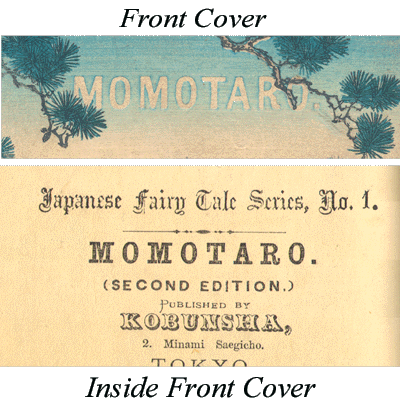
Type B. Translated Titles with "Japanese Fairy Tale Series. No. __"

Type B1. Translated Title without "Japanese Fairy Tale Series No. __"

(Seldom seen Variation)
The plain paper books with type A1, B & B1 titles are sometimes called "Saihan" (second printing). They may have a slightly different color scheme on the front cover. Despite the slightly different covers, the colophons and contents are the same.
The plain paper books measure approximately 4 3/4~5 x 7 in (12.1~12.8 x 17.7~18.6 cm).
I am of the opinion that it is accurate to call all the plain paper versions of Nos. 1-12 "First Editions." Some may be later printings but it appears accurate to call them all first editions despite minor variations in titles.
My review of these books leads me to the following tentative conclusions.
Transliterated Titles on the Front Cover:
- Type A (transliterated) titles appear (believed used only on Nos. 1-6) to be the earliest type and first editions, first printings. Use confirmed on Nos. 1, 2, 3, 4, 5, & 6 thus far.
- Type A1 (transliterated and with Fairy Tale no.) titles of Nos. 1-6 are believed to be second printings of the first edition. Use confirmed on Nos. 3 (2nd ed) & 4 thus far.
- Type A1 titles of Nos. 7-12 are believed to be the first printing of the first edition. Use confirmed on Nos. 8, 9, 10, 11, 12 & 17 thus far. Fairy Tale No. 17 (Schippeitaro) was not issued with a different or translated title.
- Type A2 titles. Use confirmed on No. 1 (2nd edition) and No. 6 thus far.
Translated Titles on the Front Cover:
- Type B (translated and with Fairy Tale No.) titles start to appear consistently with Nos 13. Use has been confirmed on Nos. 2 (2nd ed), 3 (2nd ed) 6, 8, 9, 10, 11, 12, 13, 14, 15, 16, 18, 23, 24, 25, Second Series, No. 1 and the Fountain of Youth thus far. I believe it is very likely that all numbers between 1-12 have a later (first edition but later printing) plain paper printing using the Type B title cover. Further, I believe that starting with No. 13, only the Type B cover title was used.
- Type B1 variant (translated but without Fairy Tale no.) has only been seen on Nos. 5 and 7 and those book carried "Japanese Fairy Tales, No. 5/ 7" internally with the colophon.
Plain Paper Versions with Brown (not illustrated) Outer Covers. The books discussed above all have illustrated front and back covers. A variant of these books has been recorded with plain brown covers bound in Japanese style with thin string ties. These books have a white paste on label with a decorative border which reads "Japanese Fairy Tales" at the top. Below that is the name of the tale in Japanese and translated into English. Below that is "Published by Kobunsha" and the No 2. Minami Tokyo address. On the right and left are vertical columns of Japanese text. The left hand columns give the printing and publication dates and all were printed and published in Meiji 18 (1885). The dates given correspond to the dates found on the plain paper first editions with color illustrated covers. The labels do not have a fairy tale number and none is stated internally. Books in this format are reported for "Momotaro"(No. 1), "Shita Kiri" Suzume (No. 2), "Saru Kani Kassen" (No 3), "Hana Saki Jiji" (No. 4), "KachiKachi Yama" (No. 5) and "Nedzumi no Yome-ire" (No. 6). All illustrations in these books are in black and white. Sharf, referring to these books, calls them the "first Kobunsha" books and notes they were intended for the Japanese educational market (Sharf at page 11).
Plain Paper Versions of Nos. 13-20. These numbers are probably all found in plain paper versions. I have confirmed plain paper versions of Nos 13~16 (Wooden Bowl) and 17 and 18. The plain paper versions I have seen of these are only found with translated titles which include "Japanese Fairy Tale Series No. __." (type B). The crepe paper versions carry the same type titles. Additionally Nos. 19~20 are reported in plain paper but I have not examined a copy. In a later edition of Oyuchasan, published in January of 1893, Hasegawa advertised the Japanese Fairy Tale Series, Nos. 1-20 in "Ordinary Paper & Crepe Paper." It is unclear whether the plain paper versions are first editions or whether they were published simultaneously with the crepe paper versions. However, it does appear logical that the plain paper versions were published and distributed before the crepe paper versions. The plain paper versions are uniformly larger than the crepe paper ones, measuring 17.9~18.5 x 12.1~12.5 cm.
Determining Date of Printing & Publication. As with most books, values generally vary on a particular item based upon when it was printed and published. The earlier books often command a premium over later printings. Unfortunately, often the books do not state the date of printing or edition. An additional complicating factor is the fact that dates in the Japanese colophons are often not helpful because later editions would sometimes carry colophons from earlier versions (more on this in the next paragraph). However, many of the T. Hasegawa publications give the Hasegawa address. A listing of addresses and dates is provided in the Sharf book. With the address/dates, you can get a helpful "guestimate" of when a particular books was produced. Another means of establishing the date of printing is review of the advertising list found at the back of many of the books. If the date of the last book listed/advertised is known, then the approximate date of printing of the book in hand can be bracketed. The fact that a book carries the Kobunsha (rather than Hasegawa) imprint can not be considered conclusive evidence it is an early printing (1890 and earlier). Reprints are found that carry that carry the Kobunsha imprint even after it was discontinued in favor of the Hasegawa imprint.
Reprints. To complicate dating books, one must consider the matter of reprints produced by Hasegawa. It is evident that books were reprinted at later dates but the original colophons were not changed, at least the dates. Perhaps the Japanese in the colophon denotes it as a reprint but I have been unable to confirm that. I have personally reviewed two series of books (No 1~15, first series, small 18mo, crepe) which were originally published under the Kobunsha imprint in the period from 1885~1887. The colophons in these books reflect the original printing and publication dates. However, the imprint (in Japanese in one series [c1898] and English in the other series [c1911]) is Takejiro Hasegawa, not Kobunsha. Based upon the address listed for Hasegawa in the books, and to some degree the advertising, it is very clear these are reprints. Books (Nos. 1-20) printed on plain paper are most likely first editions and not later reprints. However, they might represent different printings (first or second printings) of a first edition.
Copyright Notices. My review of Hasegawa/Kobunsha works indicates that copyright notices were not added to the books until the late-1890s. For the English language Japanese Fairy Tales No. 1-20, the presence of a copyright notice or "All Rights Reserved" notice is a strong indication that the book is a reprint or later edition. Below are examples of the Hasegawa copyright notice.
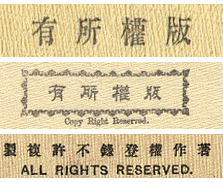
Book Binding Techniques. The vast majority of books marketed by T. Hasegawa were bound in traditional Japanese sewn binding techinques. These binding types (Yotsume toji, Kangxi and Yamato toji) are detailed below. Of these binding types, the vast majority of the books were bound in the Yamato toji style. Under special contract with Griffith, Farran & Co., the first 16 books of the fairy tale series were bound in a western type style without stab ties or external string ties. A few other non-fairy tale books were also bound in this manner.
Yotsume toji Binding. The first editions (individual books) were sometimes bound with very flimsy string ties.
 In typical Japanese style, the string/thread ties run down the spine side vertically and are secured in four places by loops which pass around the spine and through small holes punched through the book block. The string ties are very flimsy and are often missing, broken or very loose. Frankly, the binding is so weak that it seems to me that it was anticipated that the books bound in this manner would subsequently be bound into book form using a more substantial method of book binding and not publicly marketed. This style of Japanese book binding is know as Yotsume toji binding.
In typical Japanese style, the string/thread ties run down the spine side vertically and are secured in four places by loops which pass around the spine and through small holes punched through the book block. The string ties are very flimsy and are often missing, broken or very loose. Frankly, the binding is so weak that it seems to me that it was anticipated that the books bound in this manner would subsequently be bound into book form using a more substantial method of book binding and not publicly marketed. This style of Japanese book binding is know as Yotsume toji binding.
Kangxi Binding. The consolidated set volumes of first edition books with thick paper illustrated covers (Volume I, Volume II and Volume III) are bound with sturdy double string ties. I have not seen individual books bound in this manner, only larger books which are a consolidation of several individual books.
 This is known as Kangxi binding and is a traditional and sturdy Chinese and Japanese book binding technique. For an excellent illustrated step by step discussion of this binding process, click here. This Kangxi binding is much more elaborate than that used on the individual books.
This is known as Kangxi binding and is a traditional and sturdy Chinese and Japanese book binding technique. For an excellent illustrated step by step discussion of this binding process, click here. This Kangxi binding is much more elaborate than that used on the individual books.
Yamato toji Binding (Two and Four Hole Types). The vast majority of the Hasegawa books are bound at two points with ribbon/cord ties. This is known as the Yamato toji style of Japanese book binding. It is seen with double holes at each point and sometimes four holes at each point. When four holes are used the binding crossed in an "X" pattern on the front and back. In these books the spine is sometimes covered with very thin paper.
Double stab hole Yamato toji binding.

Four stab hole Yamato toji binding (often used on thicker books).
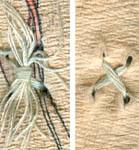
Below is an example of a rather unique binding, at least for Hasegawa books. It is tied at the side. I have only seen this style of binding used on the Aino Fairy Tales series. It is a variant of the Yamato toji style but the ties are wraped around the edge and tied off along the edge.

Condition. Evaluating the condition of these books requires consideration of several factors. Some are peculiar to the form of binding used and others are of general applicability to all books. For the folded page bound books, I discuss the factors I consider most important here.
Reference/Resource Material.
Sharf, Frederic A.:
Takejiro Hasegawa: Meiji Japan's Preeminent Publisher of Wood-Block-Illustrated Crepe-Paper Books, Salem, 1994, Peabody Essex Museum Collections, red pictorial wrappers, large 8vo (8 1/2 x 11 in), one black and white plate (photograph of T. Hasegawa) and 26 black & white text illustrations, 77 pp. Comprehensive resource on the Hasegawa crepe paper books. Well researched and documented review of T. Hasegawa's life and publishing efforts. The text follows Hasegawa's life as a publisher in a chronological order. This is followed by a section with detailed information on the various Westerners who worked with Hasegawa in the publishing enterprise (pages 32-58). These include Lieutenant F.M. Bostwick, Charles and Susan Bowles, Mae St. John Bramhall, Julia D. Carrothers, Paul Carus, Basil Hall Chamberlain, Benjamin Chappell, Joseph Dautremer, Karl Adolph Florenz, Adolph Groth, Lafcadio Hearn, Dr. James Curtis Hepburn, Mrs. Thomas H. (Kate) James, Mary G. Kimura, Shotaro Kimura, Alica Helen Little, Archibald J. Little, Arthur Lloyd, Edward Rothesay Miller, Emily Patton, Charlotte M.A. Peake, Mrs. W.H. Smith, David Thompson, Mary E. Unger and Captain P.G. Van Schermbeek. The book has a "Selected Biography" (pages 60-65) which provides detailed information on the various Japanese Fairy Tale Series books and other English language illustrated books. This information is general in terms - title, author or translator, artist, printing date, publication date, publisher (with address), woodblock printer and text printer when known. Also contains a chronological listing Hasegawa addresses. The first address is 1885 and the last is 1911 to an unstated date. To see the front cover, click here. These addresses are very helpful in determining the approximate date of printing. This book was also published in the Peabody Essex Museum Collections, Volume 130, Number 4, October, 1994.
~~ Available - Purchase Here ~~
Cortazzi, Sir Hugh:
Images of Japan 1885-1912: Scenes, Tales and Flowers, Norwich, UK, Hugh Cortazzi and Sainsbury Institute for the Study of Japanese Arts and Cultures, 2011, large 12mo (5 3/4 x 8 1/4 in - 14.7 x 21 cm), stiff illustrated wraps, numerous color illustrations, bibliography (page 129), endnotes (pages 130-38) and index (pages 139-40), 140 pp. Sir Cortazzi's book is a comprehensive overview of the various color illustrated books produced in the second half of Meiji era Japan and targeted to the foreign market. The book is organized into thirteen categories (Japanese fairy tales, children, flowers, scenery and customs, calendars, satirical books, poetry, etc). Sir Cortazzi discusses the color woodblock books (crepe and plain paper) published by Takejiro Hasegawa. Akiyama Aizaburo and Jujiya and the color (chromo-collotype and hand tinted collotype) plate books published by K. Ogawa, T. Takagi and K. Tamamura. For most books discussed you find comments on the publisher, artist, author and translator as well as extensive color reproduced illustrations. The illustrations are accompanied by detailed descriptive commentary. To see a picture of the covers, click here. ISBN 978-0-9545921-3-4.
Out of Stock
Byrne, Alexander:
Chirimen-bon or Crepe Paper Books, published in Daruma, Japanese Art & Antiques Magazine, Issue 47, Vol. 12, No. 3, Summer 2005, Japan, 8vo, illustrated stiff wraps, 58 pp. The article on Japanese crepe paper books covers pages 12 to 27. It is illustrated with 47 color illustrations. An informative and finely illustrated discussion of the Japanese Chirimen books. The Takejiro Hasegawa books are discussed with many illustrations. Hasegawa calendars (book type and hanging) are also noted. Additionally, similar crepe paper books by Akiyama Aisaburo, Hasegawa Sonokichi, SLG (Sidney L. Gulick) and S. Takashima/K. Ogawa are discussed. An important reference work for the collector of these books. To see the cover of this issue, click here.
Ishizawa Saeko:
Chirimen-bon no Subete: Meiji Obun Sashie-bon, Tokyo, 2005, 8vo (6 1/4 x 8 1/2 in), red cloth with illustrated slip cover, Japanese language, 332 pp. Roughly, the title translates "Everything about crepe paper books: Meiji era illustrated books." Perhaps the most comprehensive discussion of the illustrated crepe paper books of the Meiji era published. While the text is in Japanese, book titles and Western author's names are in Western languages. The book reads in the Japanese format from the back to the front. The front of the book has a 8 pages of color illustration of the crepe paper books. Most books have one or several black and white illustrations in the text discussion. The focus, as one would expect, is the T. Hasegawa/Kobunsha books (in all languages). Pages 243-332 contain information on Fairy Tale books produced by non-Japanese. Here you find books by A.B. Mitford, F.A. Junker von Langegg, William Elliot Griffis, H. Riddell ("Iwaya's Fairy Tales of Old Japan"), Fanny B. Greene and others. At the back, right before the colophon, are 44 pages (i-xliv) of charts and data. There include an extensive series of tables on the Hasegawa/Kobunsha Japanese Fairy Tale series. The book was obviously not intended for the person unable to read Japanese. However, much valuable information can be garnered from the illustrations, the scattered Western language titles and author's names and the tables. Many little known books are described and pictured in addition to the standard fare of Hasegawa published crepe paper book. To see the dust jacket, click here. ISBN: 4-8382-3128-9.
No Author Stated:
Takejiro Hasegawa and the History of the Crepe Paper Book, Japan (Chiba), 2001, The University of the Air (now Hoso Daigaku, Open University of Japan), except for book titles and English language names, text in Japanese only, large 8vo (8 1/4 x 11 3/4 in), stiff illustrated wraps, numerous text illustrations in color, 10 page table of Kobunsha/Hasegawa books at the rear, 33 pp. The front cover has a fold out flap. On the inside of the flap a plain paper version of Momotaro is shown. On the inside of the front cover (across from the inside of the fold out flap, a crepe textured paper illustration of Momotaro is tipped in. The first section of the book covers the Japanese Fairy Tales 1-21. Japanese Fairy Tale 1 (Momotaro) has nine different illustrations of covers of the book from plain paper to crepe paper and English to other language editions. The next section cover the Aino Tale series and pictures all three books. Next is a section on the five books that were translated by Lafcadio Hearn. This is followed by a section on "Movables, Calendars & Others." The movable books are those with a movable flap or fold out section (3 books illustrated). The Calendars illustrated include the very small ones, the book format calendars and odd shaped ones. Next is a brief illustrated discussion on the making of crepe (chirimen) paper. The book concludes with a detailed 10 page listing of Kobunsha/Hasegawa publications. There are a total of 204 numbered items listed with detailed information which generally includes the title (in English), the size (stated in mm), the printing and publication date, the translator and more. To see the front cover, click here. No ISBN.
Hollander, Michael S.:
ABMR
Hollander, Michael:
Antiquarian Book Monthly Review (ABMR) , Vol IX, No. 9, Issue 101, Oxford, UK, 1982, September issue, 8vo, paper wraps, pages 331~364. Contains an article by Michael Hollander titled List of Books Published by T. Hasegawa, Tokyo at pages 338~441. This is the earliest comprehensive English language listing of T. Hasegawa books that I have found. The author focuses on the Fairy Tale series but covers other books also and gives a wealth of information which includes title, number of pages and size. Not all these details are provided for each book however. To see the front cover, click here.
Perkins, Percival D.
Perkins, Ione
Ichikawa, Sanki (introduction):
Lafcadio Hearn a Biography of His Writings, Boston and New York, Houghton Mifflin Company, printed in Japan by the Kenkyosha Printing Company, Tokyo, gray cloth, paste on labels on front board and spine, Tokyo, 1934, 8vo, collotype frontispiece reproducing Hearn's message to the Japanese people, 444 pp. Discusses all 5 books written by Hearn and published by T. Hasegawa - The Boy Who Drew Cats (1st Series, #23), The Old Woman Who Lost Her Dumpling (1st Series, #24), Chin Chin Kobakama (1st Series, #25), The Fountain of Youth and The Goblin Spider (2nd Series, #1).
Chamberlain, Basil Hall
Tylor, Edward B. (introduction):
Aino Folk-Tales (Folk-Lore Society, XXII), London, privately printed for the Folk-Lore Society, 1888, prefatory remarks dated July 20, 1887, 8vo, paper wraps, vii, 57 pp. This is a compilation of 54 different Aino folk tales gathered by Chamberlain primarily during a stay in Hokkaido among the Aino in Summer of 1886 and during two earlier visits. While I have seen this publication described with cloth covered boards, I believe that it was bound privately or a modern reprint. I believe that the publication was originally issued by the Folk-Lore Society as a stand-alone soft-cover book. More information on this book is here.
This work was prepared at the same time that Chamberlain's Aino Fairy Tales No. 1 and No. 2 were being prepared for publication by The Kobunsha/T. Hasegawa. Variants of the three of the folk tales in Chamberlain's 1888 book are found in the T. Hasegawa color woodblock illustrated books. Information on Basil Hall Chamberlain's Aino-Fairy Tales published by Takejiro Hasegawa is here.
Riccardo, Franci:
Takejiro Hasegawa e le fiabe giapponesi del Museo Stibbert (Takejiro Hasegawa and the Japanese Fairy Tales Collection of the Stibbert Museum), Livorno, Italy, Sillabe, October 2008, square 8vo (9 1/2 x 8 3/4 in - 24 x 22 cm), stiff wraps, text in Italian and English, 300 illustrations, 204 pp. A discussion of T. Hasegawa's work and the collection of his material in the Stibbert Museum. The book is primarily a page by page presentation of the first thirteen plain paper English language Japanese Fairy Tale books published by T. Hasegawa. It contains the seldom seen plain paper version of "Kobutoro" (Japanese Fairy Tale No. 7). Each of the thirteen books is preceded by a page of comments about the book in Italian and English. To see the front cover, click here. ISBN: 978-88-8347-478-1.
~~ Available - Purchase Here ~~
A 2004 National Diet Library Newsletter (No 135) discusses the "Chirimen-bon: books made of Chirimen Paper (crepe paper)" with a focus on the T. Hasegawa books. That newsletter (No 135, February 2004) can be found here. It is interesting to note that the newsletter has the following rationale for the incomplete collection of these books in the Diet Library:
The incompleteness of the collection may be attributed to the way in which the former Imperial Library (one of the predecessors of the NDL) categorized its acquisitions. Chirimen books in minor languages or cheap editions might have been categorized as materials not worth long-term preservation. There is also a possibility that part of collections was lost in the Great Kanto Earthquake.
Various:
Anthony's Photographic Bulletin, Volume XXI, New York, E. & H. T. Anthony & Co., 1890, March issue, 8vo, contains a reproduction of a formally posed photograph of Takejiro Hasegawa.
Japanese Copyright Law. See National Diet Library Newsletter (No. 134, December 2003 ). Information can be found here. The Newsletter summarizes the Japanese copyright law as follows:
Copyright continues to exist until the end of a period of fifty years following the death of the author (Article 51). As for the duration of copyright, there are some exceptions for anonymous and pseudonymous works, the works of a legal person or other corporate body, and foreign authors. However, the basic assumption on general works is that from fifty-one years after the death of the author, the work is free from the copyright.
|































